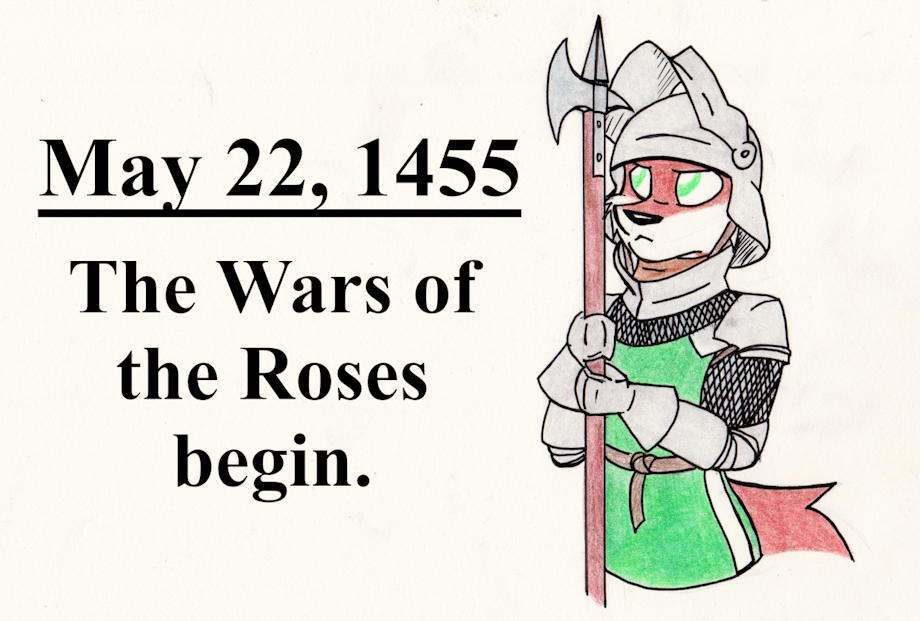On May 22, 1455, the Wars of the Roses begin with the First Battle of St Albans. The wars began with a disputed claims to the English throne by rival branches of the Plantagenet family. On one side was the House of Lancaster, headed by Henry VI (then King of England) and represented by a red rose. On the other side was the House of York, headed by Richard (Duke of York) and represented by a white rose. The wars arose in the wake of Henry VI's failed ventures in France in the Hundred Years' War and growing unrest in England. Furthermore, Henry VI had suffered from mental breakdowns, leading to the Duke of York assuming actual control of England in Henry's stead as Lord Protector. By 1455, Henry had recovered and soon afterwards his Lancastrian forces marched against the Yorkists, starting with the First Battle of St Albans in which the Yorkists emerged victorious, imprisoning Henry and resuming control over England.
However, the Lancastrians once again went to war in 1459 and this time succeeded in driving out the Yorkists and restoring Henry VI to the throne. The situation was reversed once again in 1460 when Yorkist forces invaded England and captured Henry VI once more, allowing the Duke of York to reclaim the role of Lord Protector. In the process, Richard refused to take claim of the throne but instead declared himself as the rightful heir instead of Henry VI's son, Edward of Westminster. Meanwhile, Lancastrian forces began to amass in the north of England. The Duke of York and his son, Edmund, moved to engage them but were soon killed in the Battle of Wakefield. In 1461, the Lancastrians had managed to free Henry VI during the Second Battle of St Albans but were unable to hold their territorial gains and retreated back north. At the same time, the Yorkists strengthened their positions with victories against the Lancastrians, such as at the Battle of Towton, and proclaimed the Edward, the eldest son of the Duke of York, King Edward IV. By 1464, Henry VI was once again imprisoned by the Yorkists.
Edward IV would come to alienate some of his more powerful supporters, including the Earl of Warwick. Displeased with Edward's actions, including Edward's marriage to Elizabeth Woodville, the Earl of Warwick first tried to replace Edward with George, Duke of Clarence (and Edward's brother). When this plan failed, he traveled to France and forged an alliance with Margaret of Anjou, the wife of Henry VI, to restore Henry to the throne.
In 1471, Edward IV emerged victorious at Battle of Barnet on April 14, 1471, in which the Earl of Warwick was killed. On May 4, 1471, the Lancastrians were defeated at the Battle of Tewkesbury resulting in the death of Edward, the Lancastrian heir and son of Henry VI, and the capture of Margaret of Anjou. Days later, Henry VI died while imprisoned in the Tower of London, likely the victim of murder. A relative peace reigned from 1471 until the death of Edward IV in 1483. Following Edward's death, Richard, Duke of Gloucester, moved to prevent Edward's son from assuming the throne and to keep the Woodville family out of power. In the process, he assumed the throne as Richard III.
In 1485, Richard III was killed at the Battle of Bosworth Field while fighting the forces of Henry Tudor. Henry Tudor assumed the crown and the title Henry VII, King of England and Lord of Ireland. The Wars of the Roses finally ended on June 16, 1487, with the Battle of Stoke Field and the defeat of the last major Yorkist forces in rebellion against Henry VII. The last pretender to the throne, Perkin Warbeck (who claimed to be Richard of Shrewsbury and son of the late Edward IV) led a rebellion against Henry VII in 1497 but was soon captured and imprisoned, eventually confessing to being an impostor. Initially treated well, Warbeck attempted to escape but was quickly recaptured and imprisoned alongside the last of the Plantagenets, Edward Plantagenet, the 17th Earl of Warwick. The two attempted to escape together in 1499, but were caught and executed, ending the Plantagenet line.
Keywords
male
1,212,165,
fox
250,874,
vulpine
36,859,
red fox
9,123,
this day in history
248,
tdih
244,
england
176,
york
57,
lancaster
12,
tudor
3,
wars of the roses
2,
plantagenet
1,
lancastrian
1,
may 22
1,
yorkist
1
Details
Published:
5 years, 1 month ago
23 May 2020 05:59 CEST
Initial: 5a2858a9b664de4db4c189158ec24803
Full Size: b88cd6d97702264ad0a8b2797d39fdd7
Large: 8e7bc314a89044a5b66100bd71cc3160
Small: 7ccebfe2b0d5703671df4f1334074a36
Stats
27 views
7 favorites
1 comment
